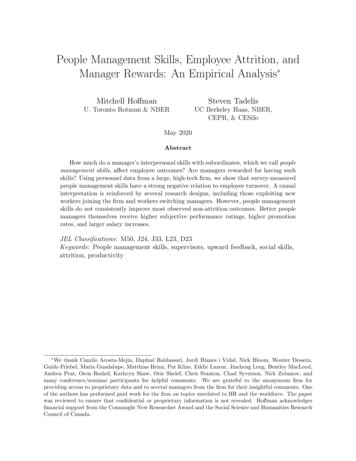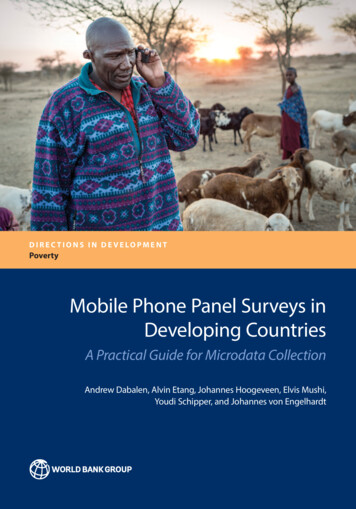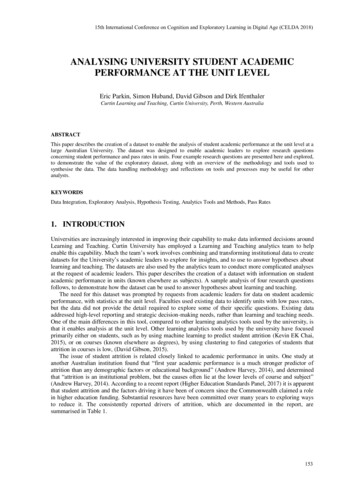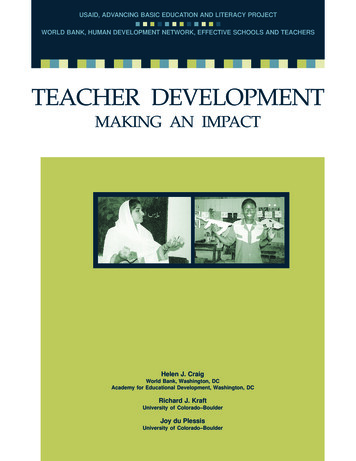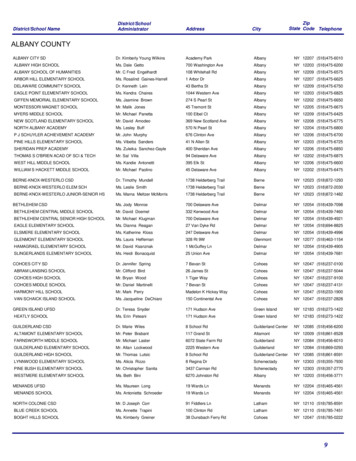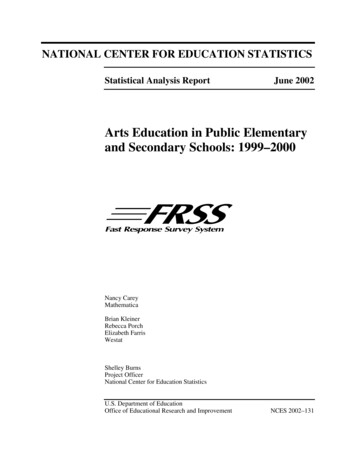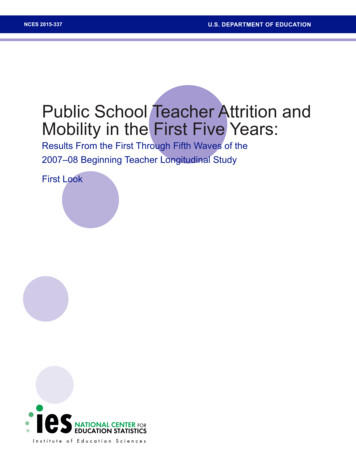
Transcription
NCES 2015-337U.S. DEPARTMENT OF EDUCATIONPublic School Teacher Attrition andMobility in the First Five Years:Results From the First Through Fifth Waves of the2007–08 Beginning Teacher Longitudinal StudyFirst Look
Public School Teacher Attrition andMobility in the First Five Years:Results From the First Through Fifth Waves of the 2007–08Beginning Teacher Longitudinal StudyFirst LookAPRIL 2015Lucinda GraySoheyla TaieWestatIsaiah O’RearProject OfficerNational Center for Education StatisticsNCES 2015-337U.S. DEPARTMENT OF EDUCATION
U.S. Department of EducationArne DuncanSecretaryInstitute of Education SciencesSue BetkaActing DirectorNational Center for Education StatisticsPeggy G. CarrActing CommissionerSample Surveys DivisionChristopher ChapmanAssociate CommissionerThe National Center for Education Statistics (NCES) is the primary federal entity for collecting, analyzing, and reportingdata related to education in the United States and other nations. It fulfills a congressional mandate to collect, collate,analyze, and report full and complete statistics on the condition of education in the United States; conduct and publishreports and specialized analyses of the meaning and significance of such statistics; assist state and local educationagencies in improving their statistical systems; and review and report on education activities in foreign countries.NCES activities are designed to address high-priority education data needs; provide consistent, reliable, complete, andaccurate indicators of education status and trends; and report timely, useful, and high-quality data to the U.S. Departmentof Education, the Congress, the states, other education policymakers, practitioners, data users, and the general public.Unless specifically noted, all information contained herein is in the public domain.We strive to make our products available in a variety of formats and in language that is appropriate to a variety ofaudiences. You, as our customer, are the best judge of our success in communicating information effectively. If you haveany comments or suggestions about this or any other NCES product or report, we would like to hear from you. Pleasedirect your comments toNCES, IES, U.S. Department of Education1990 K Street NWWashington, DC 20006-5651April 2015The NCES Home Page address is http://nces.ed.gov.The NCES Publications and Products address is http://nces.ed.gov/pubsearch.This publication is only available online. To download, view, and print the report as a PDF file, go to the NCES Publicationsand Products address shown above.This report was prepared for the National Center for Education Statistics under Contract No. ED-IES-12-D-0005 withWestat. Mention of trade names, commercial products, or organizations does not imply endorsement by the U.S.Government.Suggested CitationGray, L., and Taie, S. (2015). Public School Teacher Attrition and Mobility in the First Five Years: Results From the FirstThrough Fifth Waves of the 2007–08 Beginning Teacher Longitudinal Study (NCES 2015-337). U.S. Department ofEducation. Washington, DC: National Center for Education Statistics. Retrieved [date] from http://nces.ed.gov/pubsearch.Content ContactIsaiah O’Rear(202) 502-7378isaiah.orear@ed.gov
ContentsPageList of Tables .ivIntroduction .1Selected Findings .3References .4Estimate Tables .5Appendix A: Standard Error Tables .A-1Appendix B: Methodology and Technical Notes .B-1Appendix C: Description of Variables .C-1iii
List of TablesTablePageEstimate Tables1Number and percentage distribution of 2007–08 beginning public schoolteachers, by teacher status: 2007–08 through 2011–12 .62Percentage distribution of 2007–08 beginning public school teachers, byteacher status during each of the 4 years since starting teaching, andselected teacher and school characteristics during their first year ofteaching: 2007–08 through 2011–12 .7Percentage distribution of 2007–08 beginning public school teachers, byteacher status, type of move, and occupational status during each of the4 years since starting teaching: 2007–08 through 2011–12 .10Percentage distribution of 2007–08 beginning public school teachers whomoved across schools or left teaching since the previous year, during eachof the 4 years since starting teaching, by contract renewal status: 2007–08through 2011–12 .1134Appendix A TablesA-1A-2A-3A-4Standard errors for Table 1: Number and percentage distribution of2007–08 beginning public school teachers, by teacher status: 2007–08through 2011–12 .A-2Standard errors for Table 2: Percentage distribution of 2007–08 beginningpublic school teachers, by teacher status during each of the 4 years sincestarting teaching, and selected teacher and school characteristics duringtheir first year of teaching: 2007–08 through 2011–12 .A-3Standard errors for Table 3: Percentage distribution of 2007–08 beginningpublic school teachers, by teacher status, type of move, and occupationalstatus during each of the 4 years since starting teaching: 2007–08 through2011–12 .A-6Standard errors for Table 4: Percentage distribution of 2007–08 beginningpublic school teachers who moved across schools or left teaching sincethe previous year, during each of the 4 years since starting teaching, bycontract renewal status: 2007–08 through 2011–12 .A-7iv
Appendix B TablesTablePageB-1Weighted unit and overall response rates using base weight, by wave andretrospective status: 2007–08 through 2011–12 .B-6B-2Summary of SASS new teacher and BTLS nonresponse bias statistics, bywave and retrospective status: 2007–08 through 2011–12 .B-8B-3Summary of weighted item response rates, by wave and retrospectivestatus: 2007–08 through 2011–12 .B-9B-4Unweighted number of respondents in the BTLS sample, final-weightednumber of beginning teachers in the population, and final analysis weightvariable, by wave and retrospective status: 2007–08 through 2011–12 .B-10Appendix C TablesC-1Variables used to create teacher and school characteristics in the FirstLook report, Public School Teacher Attrition and Mobility in the FirstFive Years: Results From the First Through Fifth Waves of the 2007–08Beginning Teacher Longitudinal Study: 2007–08 through 2011–12 .vC-2
IntroductionThis report provides nationally representative data on attrition and mobility of beginning teachers in publicelementary and secondary schools. Considerable research exists on teacher attrition, retention, andmobility, but the findings are sometimes inconsistent or cover only 2 years of teachers’ careers (Ingersolland Strong 2011; Borman and Dowling 2008). To learn more about the careers of teachers from their firstyear of teaching through the next 4 years, the National Center for Education Statistics (NCES) of theInstitute of Education Sciences within the U.S. Department of Education undertook the BeginningTeacher Longitudinal Study (BTLS).BTLS is a longitudinal study of beginning public school teachers who began teaching in 2007 or 2008. 1 Itprovides data on characteristics (e.g., age and gender) and attitudes (e.g., job satisfaction) of teachers whostay in the pre-kindergarten through 12th-grade teaching profession and those who leave teaching. Thesurvey also collects data on teachers’ mobility across schools or districts. In addition, data on schoolcharacteristics (e.g., community type) are collected. The BTLS, therefore, provides researchers with theopportunity to examine the careers of beginning teachers as well as factors that may influence attritionand mobility. This report presents selected findings from the BTLS data.The Census Bureau collected and processed the BTLS data for each school year 2007–08 through 2011–12,and NCES will release these data as the First Through Fifth Waves of the 2007–08 Restricted-useBeginning Teacher Longitudinal Study Data File. In this report, the base year (i.e., the year in which theBTLS sample was selected) is referred to as the first wave or wave 1. Data collection for the first wave ofBTLS was part of the 2007–08 Schools and Staffing Survey (SASS), which began in August 2007 andended in June 2008. The approximately 1,990 first-year public school teachers who completed the2007–08 SASS compose the cohort being followed in the BTLS. 2 Data collection for the second wavewas conducted together with the 2008–09 Teacher Follow-up Survey (TFS), which began in February2009 and ended in August 2009. Data were collected for the third through fifth waves of BTLS duringJanuary through June in each of the subsequent 3 years. Although each collection contained a telephonefollow-up, the information was collected primarily through a mailed paper questionnaire for the first waveand a web instrument for the second through fifth waves. A paper questionnaire that was used in followup efforts was also developed for the second wave.Sample members who did not respond during the second wave were asked selected second-wave itemsduring the third wave. Similarly, during the fourth and fifth waves, those who had not responded duringthe previous wave were asked selected items about the previous wave. These respondents are referred toas retrospective respondents.Because BTLS is a longitudinal survey, there are several stages of response involved in calculating anoverall response rate for each wave. The overall base-weighted response rate for SASS teachers with 1 to3 years of experience 3 in 2007–08 was 73 percent. The individual base-weighted response rates for theBTLS cohort in the second, third, fourth, and fifth waves were 84 percent, 86 percent, 84 percent, and78 percent, respectively. More information about the response rates for each wave and the bias analysisconducted for BTLS can be found in appendix B.1The term “beginning teachers” is used in this report to mean teachers who began teaching in calendar year 2007 or 2008 and taught at least oneregularly scheduled class in a public school in the 2007–08 school year.2Note that 1,990 is an unweighted rounded count of BTLS sample members. More information about the sample design can be found inappendix B.3Response rates were calculated for the 2007–08 SASS public school teachers reported to have 1 to 3 years of experience, not just the beginningteachers included in BTLS. The first year of teaching was not available for nonrespondents, so it was not possible to compute a unit response ratefor beginning teachers.1
This First Look introduces new data and the selected findings chosen for this report demonstrate the rangeof information available on the First Through Fifth Waves of the 2007–08 Restricted-use BeginningTeacher Longitudinal Study Data File. The selected findings do not represent a complete review of allobserved differences in the data and are not meant to emphasize any particular issue.The tabulations in this report present results for each year of data separately. These types of results maybe used to examine behavior at different stages of teachers’ careers. For example, the percentage ofbeginning teachers who were still teaching after 1 year, after 2 years, and so on, may be examined. Foreach year, these tables present the retention rates of teachers by characteristics, the mobility (e.g., movingto a different school) for those who stayed in teaching, and the occupational status of those who leftteaching.The teacher status presented in the tables consists of current teachers (those teaching in the specified yearof data collection) and former teachers (those not teaching in the specified year of data collection).Current teachers may be divided into the following groups: Stayers: teaching in the same school in the year of data collection as in the previous year; Movers: teaching at a different school in the year of data collection from the previous year; and Returners: teaching in the year of data collection but not teaching in the previous year.The tables in this report contain weighted counts and percentages demonstrating bivariate relationshipsbetween variables. All of the results have been weighted to reflect the sample design and to account fornonresponse and other adjustments. Comparisons drawn in the selected findings have been tested forstatistical significance at the .05 level using Student’s t statistics to ensure that the differences are largerthan those that might be expected due to sampling variation. No adjustments were made for multiplecomparisons. Many of the variables examined are related to one another, and complex interactions andrelationships have not been explored. Tables of standard errors are provided in appendix A. Detailedinformation about the survey methodology is provided in appendix B. Appendix C contains a descriptionof the variables used in this report.More information about BTLS can be found at http://nces.ed.gov/surveys/btls/.2
Selected FindingsThis section presents selected findings for the 5 years of 2007–08 through 2011–12 for teachers whobegan teaching in calendar year 2007 or 2008 and taught at least one regularly scheduled class in a publicschool in the 2007–08 school year. Among all beginning teachers in 2007–08, 10 percent did not teach in 2008–09, 12 percent did notteach in 2009–10, 15 percent did not teach in 2010–11, and 17 percent did not teach in 2011–12(table 1). 4 The percentage of beginning teachers who continued to teach after the first year varied by first-yearsalary level. For example, 97 percent of beginning teachers whose first-year base salary was 40,000 or more were teaching in 2008–09, whereas 87 percent of those with a first-year salaryless than 40,000 were teaching in 2008–09 (table 2). Also, 89 percent of beginning teacherswhose first-year base salary was 40,000 or more were teaching in 2011–12, whereas 80 percent ofthose with a first-year salary less than 40,000 were teaching in 2011–12. No differences were detected between the percentages of current teachers who started teaching in2007–08 with a bachelor’s degree and those who started teaching in 2007–08 with a master’sdegree in each of the years 2008–09 (91 percent and 89 percent, respectively), 2009–10 (88percent), 2010–11 (85 percent and 88 percent, respectively), and 2011–12 (83 percent and 86percent, respectively) (table 2). In each follow-up year, the percentage of beginning teachers who were currently teaching waslarger among those who were assigned a first-year mentor than among those not assigned a firstyear mentor (92 percent and 84 percent, respectively in 2008–09; 91 percent and 77 percent,respectively in 2009–10; 88 percent and 73 percent, respectively in 2010–11; and 86 percent and71 percent, respectively in 2011–12) (table 2). During their second year (in 2008–09), 74 percent of beginning teachers taught in the same schoolas the previous year (stayers), 16 percent taught in a different school (movers), and 10 percent werenot teaching (table 3). During their fifth year (in 2011–12), 70 percent of beginning teachers taughtin the same school as the previous year (stayers), 10 percent taught in a different school (movers),3 percent 5 had returned to teaching after not teaching the previous year (returners), and 17 percentwere not teaching. During their second year (in 2008-09), 3 percent of beginning teachers were working in the field ofeducation but not as regular K–12 classroom teachers (table 3). During their fifth year (in 2011-12),5 percent were working in the field of education but not as regular K–12 classroom teachers. Among the beginning teachers who taught in a different school during their second year (in2008–09) than in the previous year (movers), 21 percent moved involuntarily or because theircontracts were not renewed (table 4). Among the beginning teachers who taught in a differentschool during their fifth year (in 2011–12) than in the previous year, 40 percent movedinvoluntarily or because their contracts were not renewed. Among the beginning teachers who were not teaching during a given year but taught the previousyear (leavers), the percentage that left teaching involuntarily or because their contracts were notrenewed was 27 percent in 2008–09, 36 percent in 2009–10, 25 percent in 2010–11, and 20 percentin 2011–12 (table 4).4Because beginning teachers may leave and later return to teaching, the percentage of beginning teachers who were not teaching in a given yeardoes not necessarily include all of those who were not teaching in an earlier year.5Interpret data with caution. The coefficient of variation (CV) for this estimate is between 30 percent and 50 percent.3
ReferencesBorman, G.D., and Dowling, N.M. (2008). Teacher Attrition and Retention: A Meta-Analysis andNarrative Review of the Research. Review of Educational Research, 78(3): 367–409.Graham, S., Chambers, L., Parmer, R., Jackson, B., Dial, S., Strizek, G., Wang, Y., and Kaiser, A.(forthcoming). Documentation for the First Through Fifth Waves of the 2007–08 Beginning TeacherLongitudinal Study (NCES 2015-355). National Center for Education Statistics, Institute of EducationSciences, U.S. Department of Education. Washington, DC.Graham, S., Parmer, R., Chambers, L., Tourkin, S., and Lyter, D. (2011). Documentation for the 2008–09Teacher Follow-up Survey (NCES 2011-304). U.S. Department of Education. Washington, DC: NationalCenter for Education Statistics.Ingersoll, R., and Strong, M. (2011). The Impact of Induction and Mentoring Programs for BeginningTeachers: A Critical Review of the Research. Review of Education Research, 81(2): 201–233.Tourkin, S., Thomas, T., Swaim, N., Cox, S., Parmer, R., Jackson, B., Cole, C., and Zhang, B. (2010).Documentation for the 2007–08 Schools and Staffing Survey (NCES 2010-332). National Center forEducation Statistics, Institute of Education Sciences, U.S. Department of Education. Washington, DC.U.S. Department of Education, National Center for Education Statistics. (2003). NCES StatisticalStandards (NCES 2003-601). Washington, DC: U.S. Government Printing Office.4
Estimate Tables5
Table 1.Number and percentage distribution of 2007–08 beginning public school teachers, by teacher status: 2007–08 through2011–12Number of teachersPercentage distributionTeacher statusYear2007–081 .Teacher 0†100.0†2008–09 .156,100140,60015,50090.010.02009–10 .156,100136,90019,30087.712.32010–112 2.717.322011–12 .6† Not applicable.1BTLS teachers began teaching in either 2007 or 2008.2The estimated total number of teachers for each year 2010–11 and 2011–12 is smaller than the estimates for the earlier years because a small number of sample members (lessthan 5) were found to be deceased during these years.NOTE: Current teachers were teaching in the year of data collection and former teachers were not teaching in the year of data collection. Because beginning teachers may leaveand later return to teaching, the number and percentage of former teachers in a given year does not necessarily include all of those who were former teachers in an earlier year. Foreach survey year 2008–09, 2009–10, and 2010–11, these estimates include those who provided data retrospectively during the next year’s survey collection. Estimates areweighted using the following weights: 2007–08 data are weighted with the first wave analysis weight (W1TFNLWGT); 2008–09 data are weighted with the second waveretrospective analysis weight (W2RAFWT); 2009–10 data are weighted with the third wave retrospective analysis weight (W3RAFWT); 2010–11 data are weighted with thefourth wave retrospective analysis weight (W4RAFWT); and 2011–12 data are weighted with the fifth wave analysis weight (W5AFWT). Detail may not sum to totals because ofrounding.SOURCE: U.S. Department of Education, National Center for Education Statistics, Beginning Teacher Longitudinal Study (BTLS), “First Through Fifth Wave Data File,” 2007–08, 2008–09, 2009–10, 2010–11, 2011–12.
Table 2.Percentage distribution of 2007–08 beginning public school teachers, by teacher status during each of the 4 years since startingteaching, and selected teacher and school characteristics during their first year of teaching: 2007–08 through 2011–122008–09teacher status2009–10teacher status2011–12teacher status2010–11teacher rentFormerTotalCurrentFormerAll 2007–08 beginning teachers . .3AgeLess than 30 years . 100.030 or more years . xMale . 100.0Female . ce/ethnicityWhite, non-Hispanic . 100.0All other races/ethnicities1 . se salaryLess than 40,000 . 100.0 40,000 or more . 100.087.596.612.5 100.03.4 ! 100.087.089.413.0 100.010.6 ! 100.083.489.516.6 100.010.5 ! 100.080.488.719.611.3Teaching statusFull time . 100.0Part time . ghest degreeLess than a bachelor’s degree .Bachelor’s degree .Master’s degree .Higher than a master’s degree2 .67.691.489.052.1 !32.48.611.047.9 !100.0100.0100.0100.080.588.488.049.5 !19.5 !11.612.050.5 !100.0100.0100.0100.082.185.188.157.4 !17.9 !14.911.942.6 !100.0100.0100.0100.061.582.885.857.2 !38.5 !17.214.242.8 eristic in first teaching year7100.0100.0100.0100.0Assigned a mentor3Yes . 100.0No . 100.0See notes at end of table.
Table 2.Percentage distribution of 2007–08 beginning public school teachers, by teacher status during each of the 4 years since startingteaching, and selected teacher and school characteristics during their first year of teaching: 2007–08 through2011–12—Continued2008–09teacher status2011–12teacher status2010–11teacher status2009–10teacher status8Characteristic in first teaching ntFormerTotalCurrentFormerEntered teaching through analternative certification program4Yes .No 16.0Certification type5Regular teaching certificate .Other certificate .No certificate .730.2Class organizationDepartmentalized instruction .Elementary subject specialist .Self-contained class .Team teaching .”Pull-out” class or “push-in” instruction 2.6 !10.3‡9.7 15.3 !10.9‡13.3 19.0 .482.520.615.0 !13.5‡17.5 !School levelElementary .Secondary .Combined .100.0100.0100.090.489.888.39.610.211.7 .272.813.621.827.2 !Community typeCity/suburban .Town/rural 17.5See notes at end of table.
Table 2.Percentage distribution of 2007–08 beginning public school teachers, by teacher status during each of the 4 years since startingteaching, and selected teacher and school characteristics during their first year of teaching: 2007–08 through2011–12—Continued2008–09teacher statusCharacteristic in first teaching yearPercent of K–12 students who wereapproved for free or reduced-pricelunchesLess than 50 percent .50 percent or more .School did not participate in free orreduced-price lunch program .2011–12teacher status2010–11teacher status2009–10teacher 16.4100.0100.084.381.415.718.6100.078.121.9 !100.071.029.0 !100.074.026.0 !100.069.0‡9! Interpret data with caution. The coefficient of variation (CV) for this estimate is between 30 percent and 50 percent (i.e., the standard error is at least 30 percent and less than 50percent of the estimate).‡ Reporting standards not met. The coefficient of variation (CV) for this estimate is 50 percent or greater (i.e., the standard error is 50 percent or more of the estimate).1All other races/ethnicities include Hispanic or Latino, Black or African-American, Asian, Native Hawaiian or other Pacific Islander, American Indian or Alaska Native, and Twoor more races.2Higher than a master’s degree includes educational specialist or professional diploma, certificate of advanced graduate studies, and doctorate or first professional degree.3Data were collected in 2008–09 regarding a mentor during the first year of teaching and do not include 2008–09 nonrespondents.4An alternative certification program is designed to expedite the transition of nonteachers to a teaching career; for example, a state, district, or university alternative certificationprogram.5Teachers were asked “Which of the following describes the teaching certificate you currently hold in THIS state?” Regular teaching certificate includes teachers reporting one ofthe following, regardless of any other certifications held: (1) regular or standard state certificate or advanced professional certificate; or (2) certificate issued after satisfying allrequirements except the completion of a probationary period. Other certificate includes teachers reporting one of the following: (1) certificate that requires some additionalcoursework, student teaching, or passage of a test before regular certification can be obtained; or (2) certificate issued to persons who must complete a certification program inorder to continue teaching. No certificate includes teachers reporting, “I do not hold any of the above certifications in THIS state.”NOTE: Current teachers were teaching in the year of data collection and former teachers were not teaching in the year of data collection. Because beginning teachers may leaveand later return to teaching, the percentage of former teachers in a given year does not necessarily include all of those who were former teachers in an earlier year. For each surveyyear 2008–09, 2009–10, and 2010–11, these estimates include those who provided data retrospectively during the next year’s survey collection. Estimates are weighted using thefollowing weights: 2008–09 data are weighted with the seco
The term “beginning teachers” is used in this report to mean teachers who began teaching in calendar year 2007 or 2008 and taught at least one regularly scheduled class in a public school in the 2007–08 school year. 2. Note that 1,990 is an unweighted rounded count of BTLS sample mem
